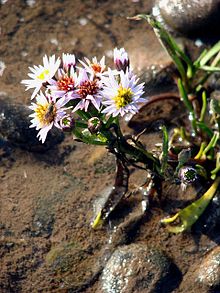| Sea aster | |
|---|---|

| |
| Scientific classification | |
| Kingdom: | Plantae |
| Clade: | Tracheophytes |
| Clade: | Angiosperms |
| Clade: | Eudicots |
| Clade: | Asterids |
| Order: | Asterales |
| Family: | Asteraceae |
| Genus: | Tripolium |
| Species: | T. pannonicum
|
| Binomial name | |
| Tripolium pannonicum | |
| Synonyms[1] | |
| |
Tripolium pannonicum, called sea aster[2] or seashore aster[3] and often known by the synonyms Aster tripolium or Aster pannonicus, is a flowering plant, native to Eurasia and northern Africa,[4][1] that is confined in its distribution to salt marshes, estuaries and occasionally to inland salt works.
It is a perennial growing up to 50 cm tall with fleshy lanceolate leaves and purple ray florets flowering from July to September. The plants tend to be short-lived and populations need significant new recruitment each year from new seedlings. There are rayed as well as rayless varieties and only the former have long blue or white florets. The rayless form is yellow. The plant flowers well into autumn and hence provides a valuable source of nectar for late-flying butterflies such as painted lady and red admiral.
Young leaves of this plant are edible and are collected for consumption on the floodplains of the Dutch province of Zeeland.[5]
Sea aster was celebrated as the subject of a definitive stamp issued by the Irish post office, An Post, designed by Susan Sex.[6]
- ^ a b c Greuter, W. (2006), "Tripolium pannonicum", in Greuter, W.; Raab-Straube, E. von (eds.), Euro+Med Plantbase - the information resource for Euro-Mediterranean plant diversity, retrieved 2014-08-23
- ^ USDA, NRCS (n.d.). "Tripolium pannonicum". The PLANTS Database (plants.usda.gov). Greensboro, North Carolina: National Plant Data Team. Retrieved 15 December 2015.
- ^ English Names for Korean Native Plants (PDF). Pocheon: Korea National Arboretum. 2015. p. 367. ISBN 978-89-97450-98-5. Archived from the original (PDF) on 25 May 2017. Retrieved 26 January 2017 – via Korea Forest Service.
- ^ "Tripolium pannonicum". Germplasm Resources Information Network. Agricultural Research Service, United States Department of Agriculture. Retrieved 22 December 2017.
- ^ "Culinary surprises from Zeeland". www.zeeland.com. Retrieved 31 October 2024.
- ^ An Post. "Wild Flowers of Ireland - 82c sea aster stamp". anpost.com. Retrieved 2024-08-20.